16 September 2021
The Nuremberg Residenz is too groß and grand, Bamburg Residenz too small and simple, but Würzburg Residenz is just right.
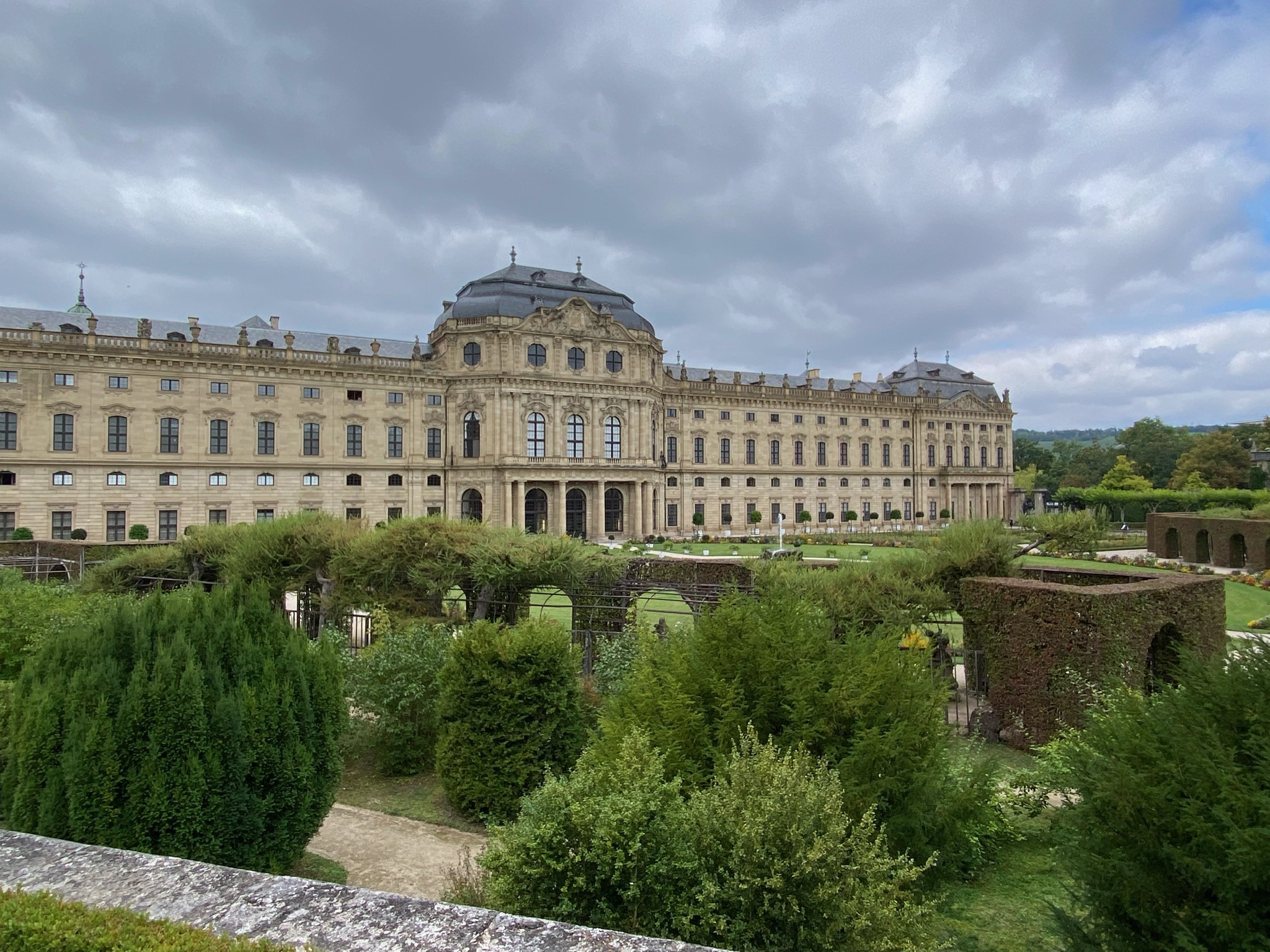
Würzburg Residenz
From its entry foyer where carriages debarked its elite passengers under a 3D fresco to flow past the spectacular oval Garden Hall with its massive windows, pink marble columns, white stucco putti and vibrant frescos, to climb the Grand Staircase with its gorgeous high ceiling frescoes and life-sized sculptures, the 18th century Würzburg Residenz was meant to impress. And that includes the female statue at the top of the staircase gazing sweetly at her beheaded prince.
Würzburg Residenz was principally built in the mid 1700s, brutally battered during 1945 bombings, and lovingly restored since. An UNESCO World Heritage site since 1981, the palace is a mix of what they call Goût Greek style and Neoclassical. The preponderance of Italian influences and Venetian art comes from German princes who ruled as Kings of Rome and Holy Roman Emperors.
Throughout, there are lovely rooms filled with priceless tapestries, frescoes and art. However, there are several spectacular rooms. The Green Lacquered Room is a spectacle of green lacquered walls applied as glaze with decorations of gold stucco swirls framing mirrors and frescoes. The room is filled with charming putti and colored-glass chandeliers above gorgeous wood inlaid floors.
The “ordinary guest room”can boast that “Napoleon slept here” but is otherwise unremarkable. His wife Maria-Louisa also stayed overnight as her uncle was the Duke of Würzburg at the time.
The oval Emperor’s Hall is over 4,300 square feet of stunning pink marble, allegorical frescoes, marble floor, 52-foot ceiling, pink stucco marble columns and tons of gilding. All is brightened by massive crystal chandeliers. Not an inch is unadorned. Don’t miss the favored pooch over the doorway. All was built 1749-1753 so the design reflects both rococo styling and a later neoclassicism. The Venetian glass chandeliers were made by a Würzburg court glass manufacturer around 1750.
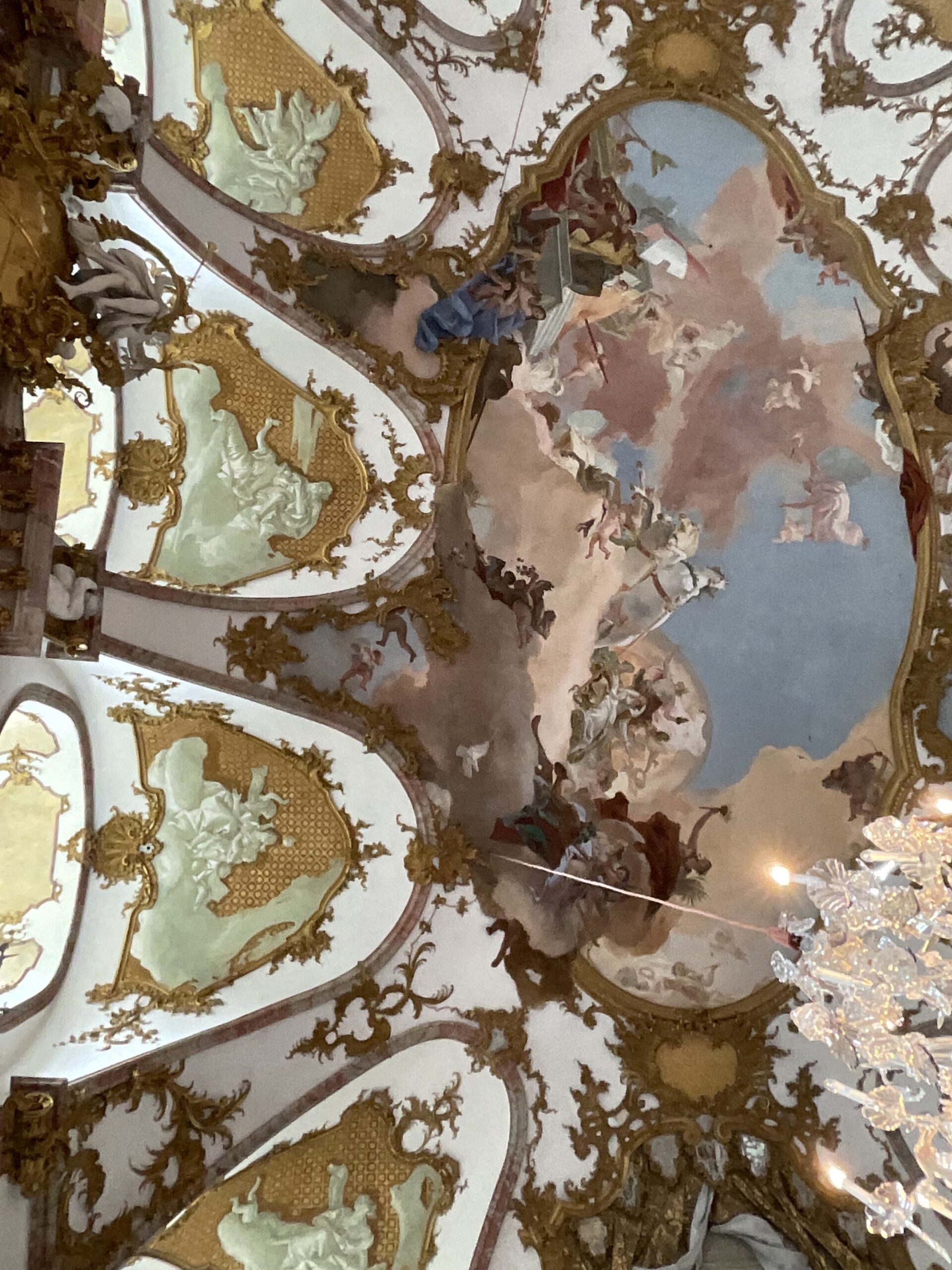
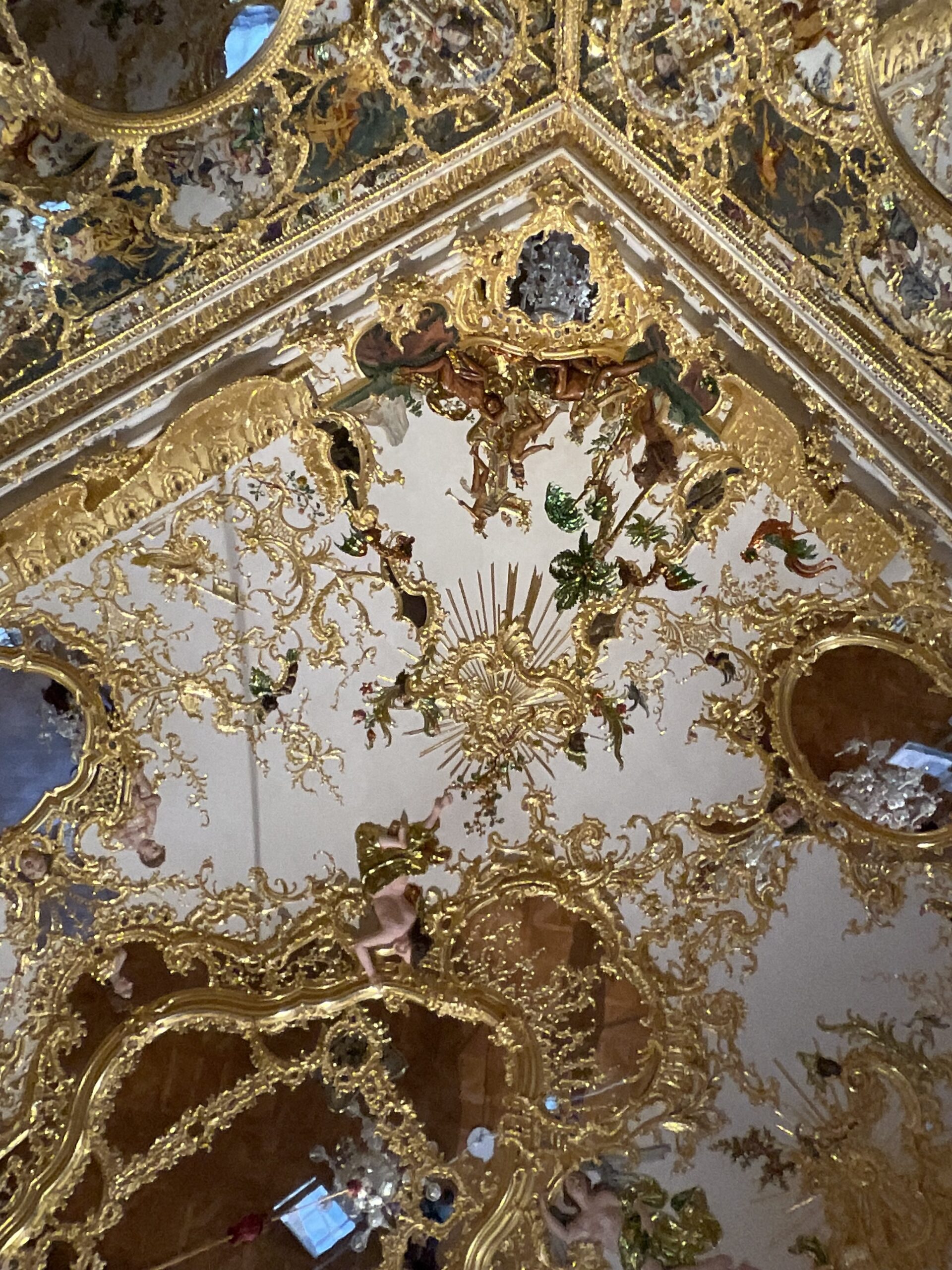
Just when I think it couldn’t get more elaborate, I entered the Mirror Cabinet. This part of the residenz was destroyed in bombing raids but using photos, fragments and paintings, the room has been restored to its full magnificence. Unlike the typical cabinet room designed to display collections of porcelain, this room’s mirrors were painted with floral and garden motifs. It truly is a masterpiece of design.
Much of the Würzburg Residenz, in fact about 90% of medieval Würzburg, was destroyed during a 17-minute firestorm by the RAF on 16 March 1945. American forces were at the banks of the Main below Marienberg Fortress during German efforts to blow up the bridges of Würzburg as their last act of defiance. Museum displays recognized the heroic efforts of 2nd Lieutenant John Davis Skelton to find materials for temporary roofs that resulted in saving many frescoes and art works from the elements. Fire destroyed the wooden ceilings and floors.
The rebuilding of this beautiful residenze is ongoing. Just follow the numerous “Rundgang” arrows throughout. You won’t loose your way as you wander pretty much alone through the rooms of this magnificent palace. And be sure to spend time wandering the beautiful Hofgarten for a restful pause before heading into the old city.
Dom St. Kilian

The first diocese was founded by Saint Boniface in 742 when he appointed the first Bishop of Würzburg. The first church on the site of the present Würzburg Cathedral was built as early as 788 and consecrated that same year by Charlemagne. The current Dom St. Kilian began construction in 1040 in the Romanesque style. While the museum is closed because of Covid restrictions (too small a space for visitors), the cathedral is open to enjoy. Its simple white walls are adorned with marble icons and alters while the ceiling is an extravaganza of plaster and stucco putti angels, swirls and vines. The tombs below are open to visit. The only distraction is the constant rumble of the passing trams.
Würzburg was also a site of especially virulent Witch Trials during the Thirty Years War between 1626 and 1631. Here was held one of the largest peace-time mass trials. Under the Würzburg Bishop an estimated number between 600 and 900 alleged witches were burnt. In 1631, Swedish King Gustavus Adolphus invaded Würzburg, plundered the castle and put an end to the nonsense.
Alte Mainbrücke

Alte Mainbrücke or Old Main Bridge is 590’ long and adorned with 15‘ statues of Saints. It spans the rushing waters of the River Main and offers fantastic views of Marienberg Fortress and its terraced vineyards. The first bridge here is thought to have been built about 1133; this newer version came in 1476. The statues came later. Final stone arches were finished in 1703. During the more brutal past, “open-air” trials were held on the bridge and those convicted were thrown from the bridge into the rushing Main.
Würzburg Town Hall and Würzburger Ratskeller
On the city side of the Alte Mainbrücke is the Vierröhrenbrunnen or Four Tubes Fountain, an 18th century Baroque fountain with obelisk, statues and Franconian dukes’ coats of arm. It sits directly in front of the ornate Würzburger Ratskeller. Structurally, this restaurant is the old council chapel and part of the large building complex of the Rathaus or Town Hall. The Rathaus consists of several buildings, mostly rebuilt after WW2, with the oldest structure the Grafeneckart (bell tower) dating as early as 1316. Besides historic frescoes, also on site is the historic Wenceslas Hall and a memorial room for the victims of the bombing attack on the city on 16 March 1945. After the 20-minute bombing raid, only 7 buildings in Würzburg remained in tact.
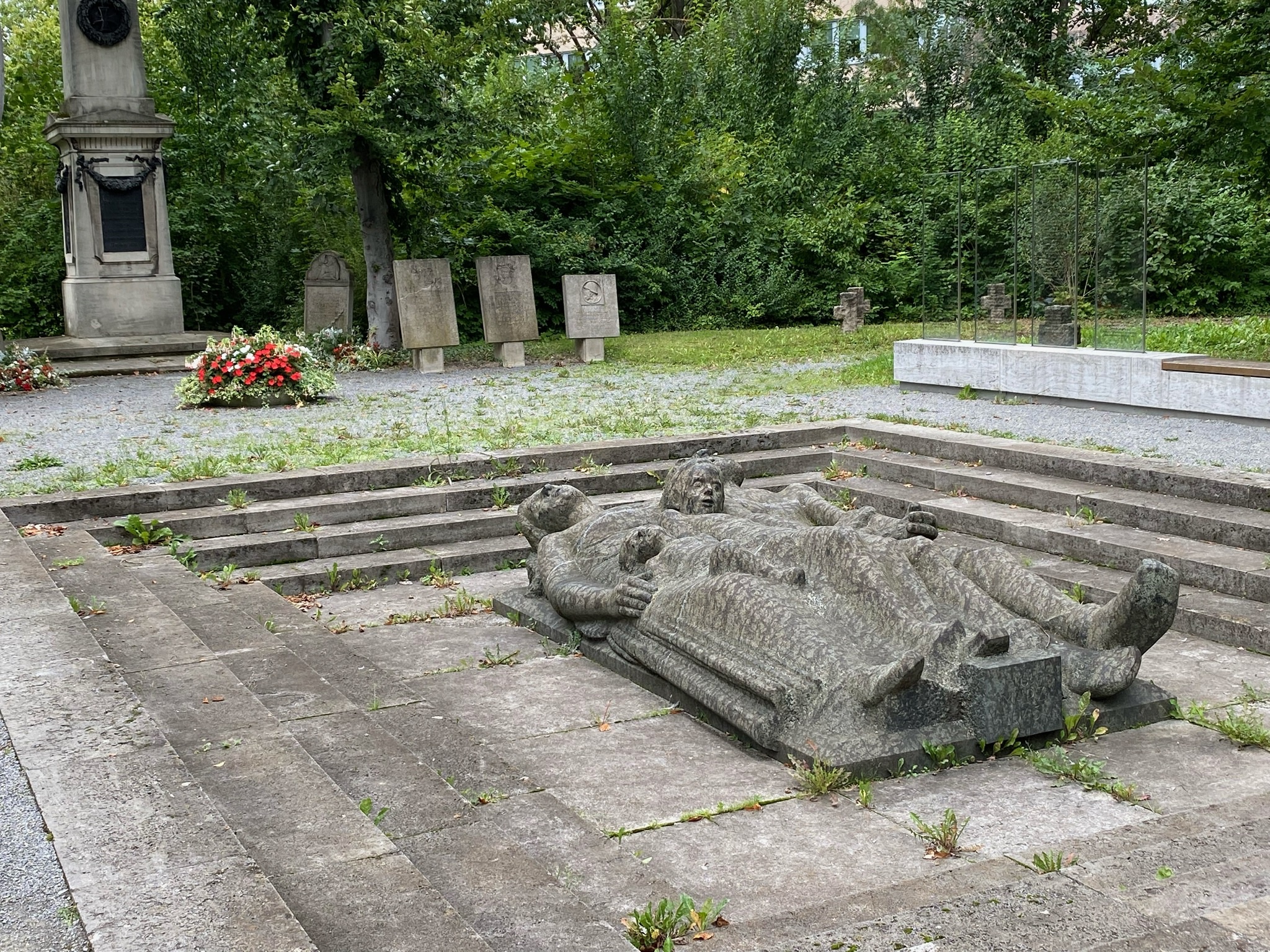
The display expressed something on my mind of late: “The city Council of Würzburg has intensively deliberated on a new form of the memorial room to the air raid of March 16, 1945. Germany’s responsibility for the colossal crimes of National Socialism and for the destruction wrought by WW II was to be expressed clearly but, on the other hand, the suffering of the people in Germany and particularly in Würzburg was to find an appropriate description as well…The air war as conducted in the last phase of WW II demanded untold thousands of lives, particularly of unarmed women, children, and seniors, and from the late war years up until the present day a debate has been going on both among the victorious war allies and in Germany as to whether that kind of warfare was justified or has to be considered a war crime…the dead… will not return to life, destruction of the city cannot be undone. What remains, as well, is the lasting admonition to us to stand firmly against war, against any reign of terror, and against racism.“
In 2021 United States, these events and lessons need to be considered.
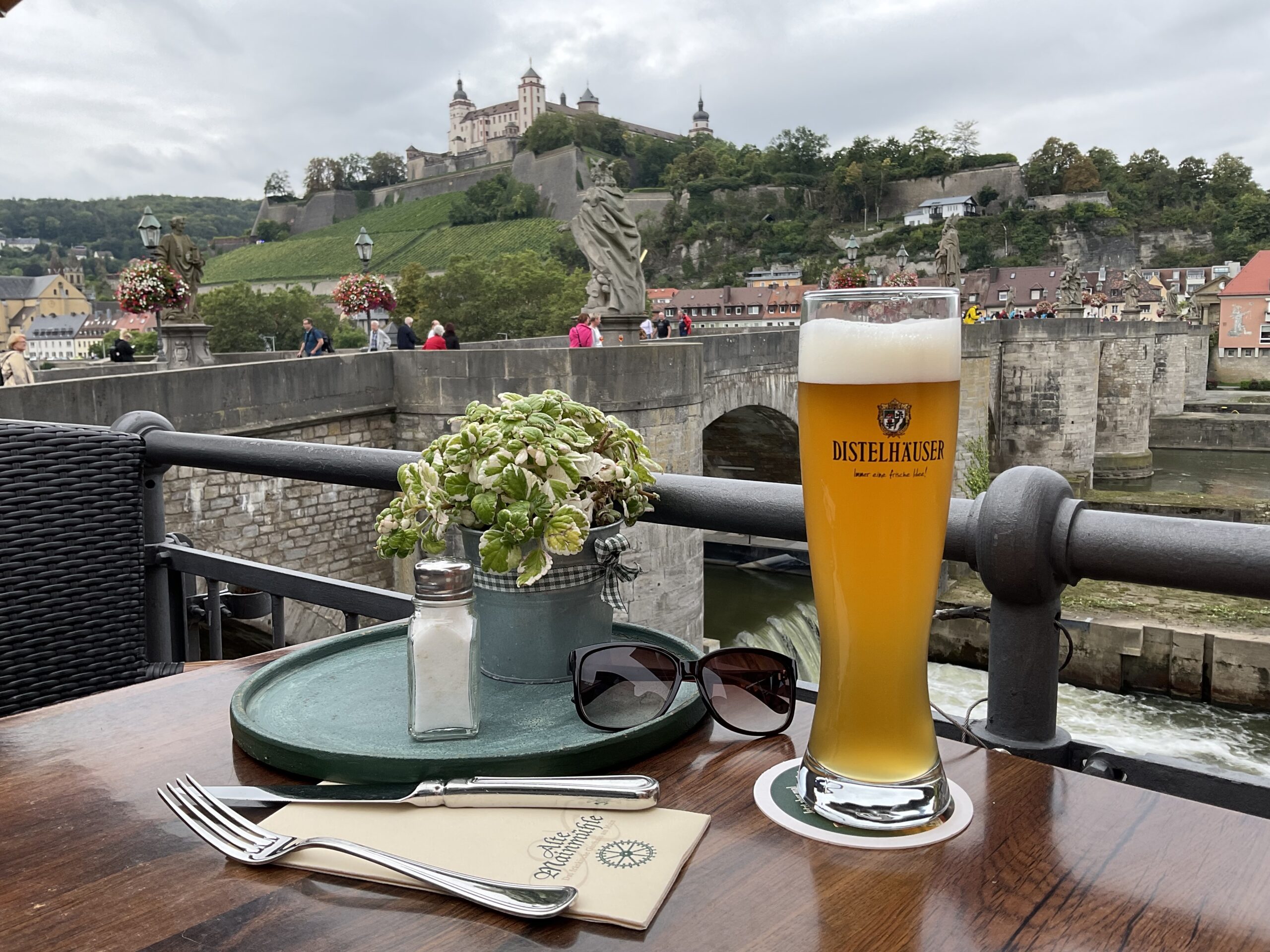
Marienberg Castle
Since the Bronze Age, a castle has sit upon a high hill overlooking historic Würzburg. The Celtic were represented by the Alamanni in the 4th to 5th centuries; a Roman fort stood on the hill; the Franks hung out in the 6th to 7th centuries. Today, it is the site of Marienberg Fortress, a formidable edifice and even more formidable climb!
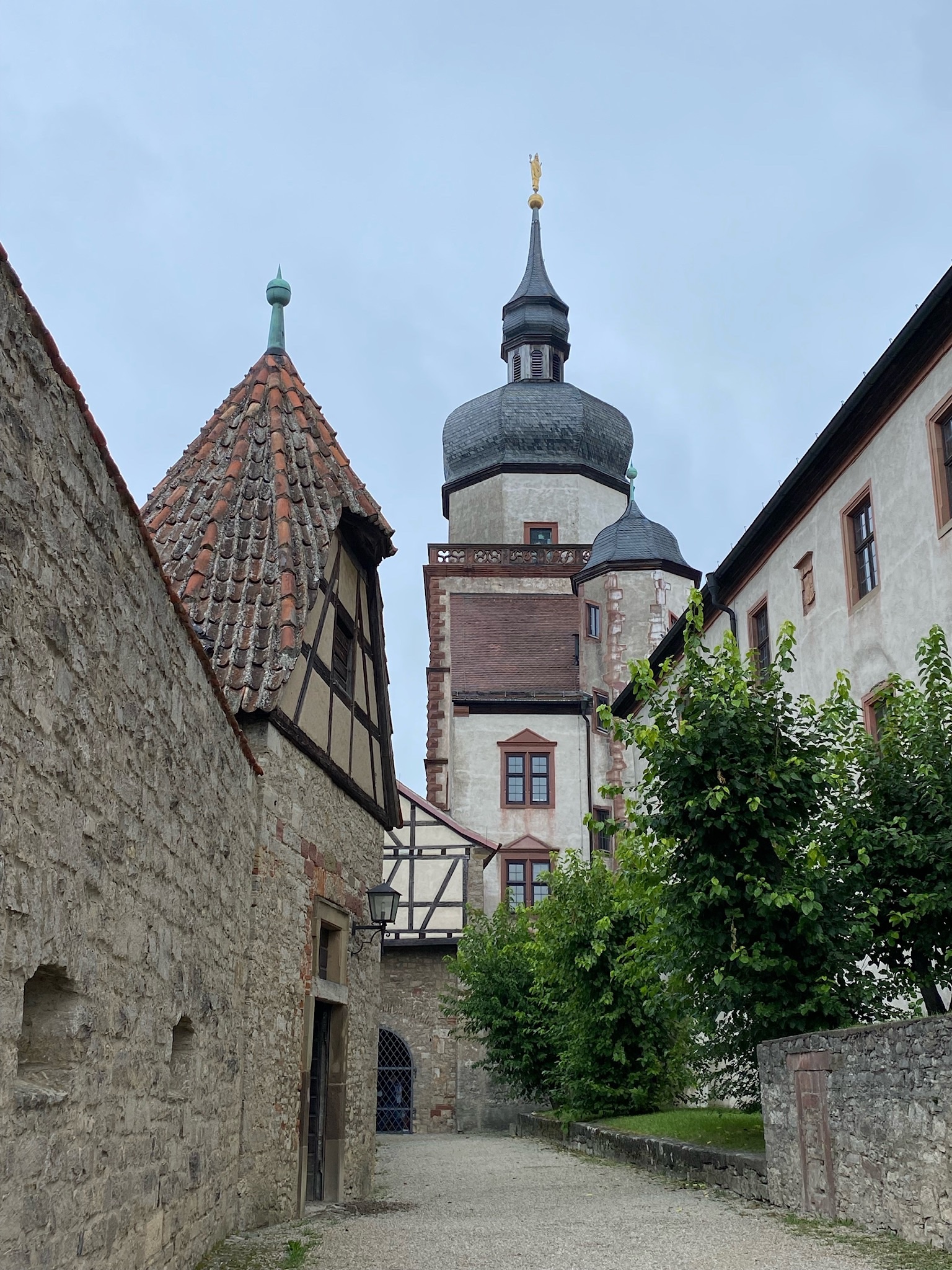
The original castle was probably a small fort built early in the 8th century by the Franconian-Thuringian dukes. From 1200 the castle was extended during the late Middle Ages and the Renaissance. From around 1250 to 1720, the Marienberg was the ruling seat of the Würzburg prince-bishop and Duke of East Franconia.
Following the successful storming of the castle by the Swedish army in 1631, Prince-Bishop Johann Philipp von Schönborn built a circle of massive bastions, which are what you see today from the lower city. In 1945 the fortress was almost completely burned out, and its reconstruction was only completed in 1990. There was little that was open beyond the courtyard but one can peek at the circular Marienkirche, which dates back to AD 706, the 130′ fortified central tower, and the well house with a 330′ deep cistern. On the south side of the fortress walls, the massive, four-storey defense casement built 1724-1729 is the Maschikuli Tower.
The Princes Garden, accessible from the castle courtyard, probably acquire its present form around 1700; the balustrades sport the Schönborn coat of arms, thus placing their development during the time of Prince-Bishop Johann Philipp von Schönborn (1642-1673). The Princes’ Garden, its flower beds and fountain, are relatively small but there is a magnificent view of Würzburg and the valley of the River Main. To the right is a clear view of Würzburger Käppele, the large yellow and white Capuchin sanctuary high above the Main.
In the Arsenal, old stables and the Princes’ Building, the state Museum of Franken Art and Culture shows an outstanding collection of treasures. Though the castle courtyard is filled with groups off the river cruises and gaggles of very disinterested German students, I am all but alone in the museum. There is an excellent display of intricate lock and key mechanisms, compasses, and pocket time pieces dating as early as 1700. On a lower floor is displayed their collection of prehistory items excavated from around Franconia, including pottery, stone and bronze artifacts.
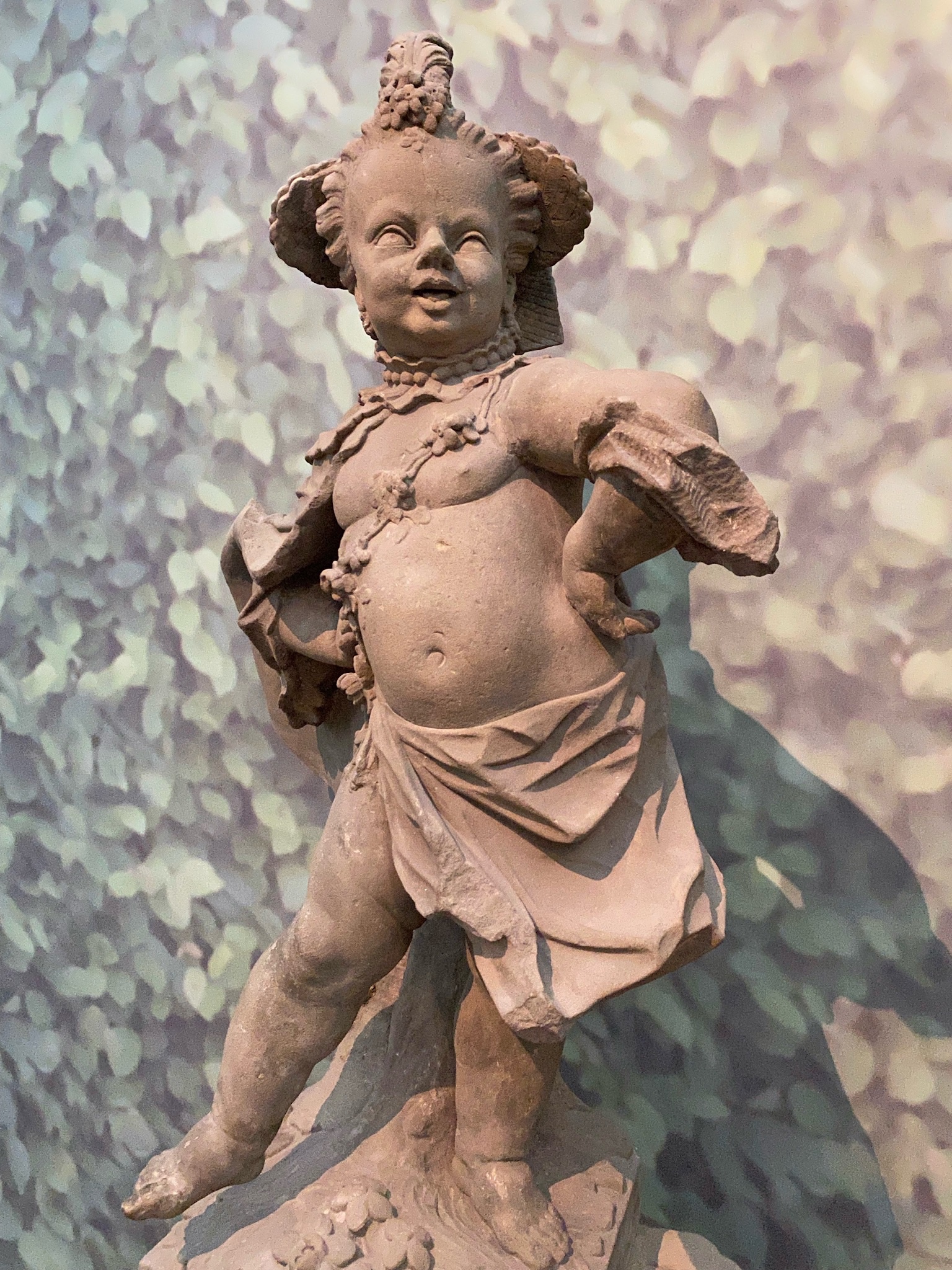
The German sculptor Johann Peter Alexander Wagner (1730-1809) is also well represented. Wagner was an accomplished sculptor by 1771 when he became the Court sculptor to the Prince-Bishop of Würzburg. He created many works for the Residenz and gardens from furniture, decorative carvings, religious works, to staircases and statues. There is a section showing how he worked from a sketch to detailed drawing to molding in clay. Wagner primarily worked in clay, wood and marble and his work can be seen all around Würzburg. Also displayed is statuary of Ferdinand Tietz, Bamburg Court sculpture – his figures of mischievous children for the Veitshöchheim summer palace are delightful.
The display at the Würzburg Town Hall explained that over 5000 citizens died in the 16 March 1945 bombing raid. They are buried in a mass grave at the Hauptfriedhof or Central Cemetery. I decided to walk through the beautiful Ringpark, a large green space which encircles the city. The day is brisk and fall is in the air. Leaves are quickly turning to yellows, reds and browns of fall. My walk passes a memorial to German soldiers, gentlemen playing bowls, and then Würzburg’s large monumental Cemetery. One does not need to understand German to know what the stone sculpture represents – here lie the victims of the last days of WW2.

0 Comments